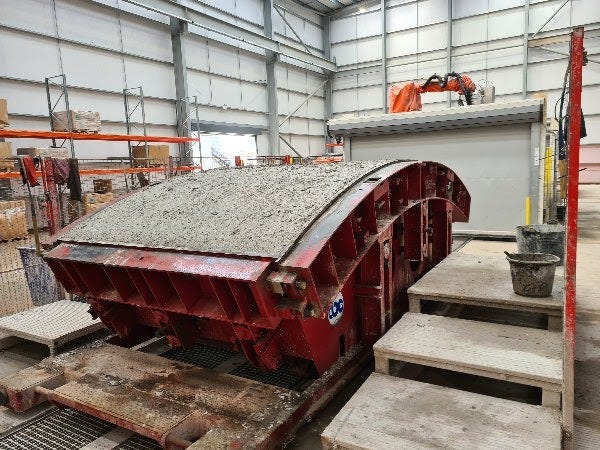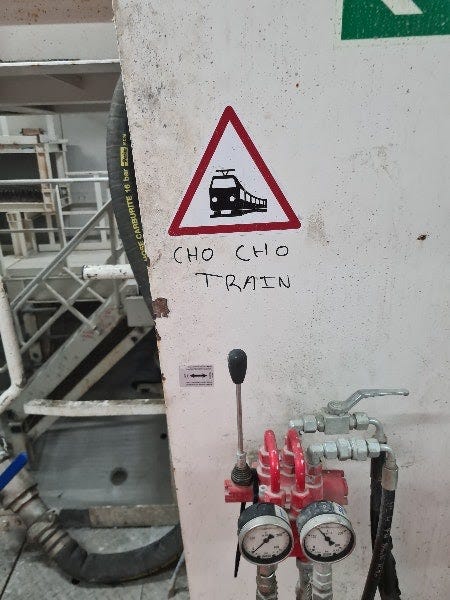Day Of The Tunnel Boring Machine
Some non-festive reading material.
So I figured that, if you didn’t make it home for Christmas this year, you’d be looking for something to distract yourself from the full horror of reality right about now. And if you did make it home for Christmas this year, you’re probably looking for something to distract yourself from your family right about now.
Either way, this week I’m going to release three previously paywalled things I’ve written for the newsletter this year in the hope of providing that distraction. Ideally they’d fit into a sort of Christmas past, present and future pattern, but they don’t so I’m not going to attempt to justify the choice except to say that I was quite pleased with them and thought/hoped you might enjoy them.
Below is the first: the story of the day I spent learning about tunnel boring, somewhere under the Chilterns. I hope that, wherever you are, you’re warm and safe and that 2022 brings happier things. Thanks for reading this year. It’s very nice that you do.
Everything I learned in a morning hiding in a tunnel under the Chilterns
Hi Jonn,
I hope you’re well. This is just a quick note to see if you would be interested in a guided tour of one of HS2’s first two tunnelling machines (TBMs)... They are essentially huge underground factories that excavate the chalk and build the walls around themselves as they push forward.
Thus read an email from a chap in the PR team at HS2. I’d been looking for something to do on Compendium publication day that wasn’t either “same as any other day” or “wander round bookshops worrying about my lack of prominence”, so a morning under a hill learning about tunnel boring seemed like a great idea. What’s more, the other journalists going were a cross-section of a) the Twitter rail nerd elite, and b) my mates. It’d be like a school trip, but for grown ups. I had to say yes, right?
So, I did. On a sunny Thursday in mid-September, I got up at an hour I hadn’t risen at in years and travelled to the far western reaches of the Central line in search of something boring.
I was expecting to learn things. I was expecting to have fun. What I was not expecting, though, was that there’d be a moment that felt akin to how I imagine religious people experience faith, in which I stood looking at the magnitude of creation and felt genuinely overcome by emotion.
Here’s what I learned.
1. Cecilia and Florence, the two TBMs in question, exist to dig a pair of 10 mile tunnels under the Chilterns, north west of London. Trains from London Euston will emerge from tunnels around West Ruislip, run for two miles across the Colne Valley viaduct, the UK’s longest railway bridge, before diving under the chalk hills.
The new trains will technically have a top speed of 360km/h, but will be scheduled to run at just 320km/h – that last spurt is reserved for catch up – and the tunnel engineered accordingly. Basically, the faster your trains, the straighter your route has to be. The slower trains give you a bit more bend.
The current mouth of the tunnel. If you look carefully, you can see the shrine to Saint Barbara, the patron saint of tunnellers.
2. Getting to Cecilia involved donning a load of personal protective equipment – high-viz, steel toed boots, a complicated emergency breathing device, which our guide reassured us he’d never actually had to use in 20 years – then walking for around a mile along a metal gantry. The tunnel is lit by a combination of distant daylight and surprisingly bright LED strips, plus occasional green lights to mark the presence of emergency telephones. (Green light is most visible through smoke.)
Inside the tunnel. Note the emergency breathing device hanging from the back of the unknown male in front of me.
You can measure your progress by the numbered concrete rings lining the tunnel, each 2m wide.
3. Cecilia herself – named after the local astronomer and astrophysicist Cecilia Payne-Gaposchkin; the name was suggested by local school kids and chosen by public vote, presumably because PR – is 180m long. To put that in context, a Boeing 747 is around 76m; a double decker bus under 20.
Why that length? Because the machine isn’t just digging the physical space, but also laying the cables and pipes and installing the concrete rings necessary to turn it into an actual tunnel: each of these come in standardised lengths, so that the crew know a new section of piping is needed every six rings, say.
In other words, the TBM is like a production line. Her (screw it, I’m going with “her”) six articulated gantries also include control rooms; bathrooms; a kitchen/mess room, complete with more than one variety of peri peri sauce; and a pair of “refuge chambers” where her crew of 17 can shelter for several hours in the event of emergencies.
4. At the very front of the machine is a steel bulkhead, beyond which is the cutting surface. The pilot can see a map of this, live, at any one time, and adjust the machine to take account of faults, unexpectedly tough areas, and so on.
The cutting surface, incidentally, is pressurised, to prevent it from flooding with groundwater: reaching it involves going through a pressure chamber.
5. The chalk excavated from the cutting surface is mostly liquified in a tank, and then pumped out. The water is then drained off, and the chalk piled up, very slightly raising the ground not far from the tunnel.
That’s one of the pipes running the length of the tunnel (and very noisy it is too; the liquidation process turns out to be imperfect). There are also huge ventilation pipes, pumping in fresh air, and pushing the air already present out towards the tunnel mouth.
A section of ring being manufactured.
6. Here’s the bit that gave me the quasi-religious experience.
The concrete rings for the tunnel walls are manufactured in a factory on site, a few hundred metres from the tunnel mouth. Each ring is made up of seven pieces, 8.5 tonnes in weight, and each is very slightly wider on one side than the other: alternating them results in a straight tunnel, consistently facing them the same way creates a gentle curve.
All of this is done automatically: a robot arm picks up an eight tonne slab of concrete using vacuum suction, slots it into place the right way around, then moves onto the next one. It’s all pre-programmed. It is genuinely one of the cleverest, most astounding things I have ever seen, and for about three minutes I just watched it open-mouthed, unable to focus on what anybody was saying because I was feeling what I can only describe as awe at quite how clever people can be.
7. None of this is cheap, of course: tunnels cost roughly six times as much as surface railway, but NIMBYs gonna NIMBY. It is surprisingly fast, though. The TBMs can run 24 hours a day, cutting as much as 30m of new tunnel in that time, though their average progress is closer to 15m. The entire machine can move forward into the space it’s created at around 6cm a minute – fast enough that you can see it, just about.
Florence (after Nightingale) started her journey first, so is around a mile deeper into the Chilterns: behind her, unlike Cecilia, there is now a concrete floor.
I promise I didn’t write this.
8. One of the TBMs which built the Channel Tunnel is still buried beside it. These guys, though, will emerge from the ground near Great Missenden, to be disassembled and their parts reused.
The Chilterns can be beautiful, which is why the railway is going to be in tunnels. Oddly enough, though, tunnel engineering can be really quite beautiful, too.
If you liked this email, and would like to receive one every week containing more, then you can become a paying subscriber for £4 a month, or £40 a year: either way, that’s less than £1 a week.
Questions? Suggestions? Complaints? Leave a comment:





Loved reading this Jonn, really brings out the incredible engineering of tunnelling projects. I would love to share it on LinkedIn if you decide to publish it there. Wishing you a Merry Twixtmas and wonderful 2022! Best as ever, Moya 🎄🎄😊😊😊